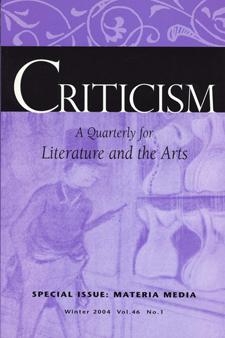Volume 46, Issue 1 (2004) Materia Media
Preface
CRITICISM: THE NEGATIVE connotations of the word are not far to seek, whether in the direction of the musty irrelevance of an over-fastidious and hermetic scholarship or the brutal attacks of the sort encouraged in the “criticism sessions” of Mao’s Cultural Revolution. But in the academy—and perhaps still more so beyond it—the necessity of criticism presses on us with fresh urgency. Its traditional strengths, well represented in the pages of this journal over the years, include a devotion to particulars and a rigor of analysis that seem especially valuable not only in light of the current theoretical and methodological eclecticism of literary, cultural, and visual studies but also in the context of a political climate in which critical voices are too little in evidence, Orwellian language use too much the norm and too rarely called to account. In this, the journal’s new incarnation, we aim to make Criticism a venue for adding capaciousness to the word and the practice. Such capaciousness demands, at least, searching attention to criticism’s enabling assumptions, varied procedures, divergent aims, frequent failings, and occasional impossibilities. Among the many changes we have instituted to prepare the way for these new engagements, two merit special mention: First, Criticism features a new, external Editorial Board comprising scholars and critics whose own work exemplifies theoretical and methodological sophistication within and across disciplinary boundaries: Srinivas Aravamudan, Lauren Berlant, Lisa Cartwright, David L. Eng, Rita Felski, N. Katherine Hayles, Jonathan Lamb, Mary Poovey, Erica Rand, Valerie Smith, Peter Stallybrass, and Paul Strohm. We are grateful to all of them for their generosity and expertise. Second, to initiate and mark the journal’s new direction, we have arranged for three special issues to be published in this volume. The first, “Materia Media,” consists of essays on media, mediation, and materiality by members of the Department of English here at Wayne State; it also includes two review essays—one on Romanticism, another on the turn to religion in Early Modern Studies—as well as an extended review of and meditation on Brian Massumi’s Parables for the Virtual (2002). In the second, guest editors Joseph Loewenstein and Paul Stevens gather work exploring the possibilities and limits of 7 public sphere discourse in the early modern period, asking, as their title has it: “When Is a Public Sphere?” Finally, guest editors Vanessa Agnew and Jonathan Lamb put together a collection of essays addressing the epistemological and ontological stakes of reenactments, experiments in living history, and a wide range of related phenomena that they place under the heading “Extreme and Sentimental History.” Each of these special issues promises intellectual excitement of the sort we hope to make a hallmark of the journal. “The history of thought is the history of its models.” Thus Fredric Jameson in The Prison-House of Language (1972), addressing the rise and fall of such once-privileged epistemic metaphors as the organism, evolution, and linguistics. Not hubristic enough (fortunately!) to imagine the role of Criticism so world-historically, we do aspire to provide a site where thought and models for thought in the humanities can be explored, subjected to critique, given social and political purchase, reworked, disentangled, fused—in short, renewed.Preface
Introduction: Materia Media
Cannon Schmitt
Articles
Premediation
Richard Grusin
Reading into Henry James
Jonathan Flatley
The Life, After Death, of Postmodern Emotions
Steven Shaviro
The Turn to Religion in Early Modern English Studies
Ken Jackson and Arthur F. Marotti
Book Reviews
Intersections of Science, Sensation, and Culture
Charles J. Stivale
Inside and Outside Romanticism
Michael Scrivener

